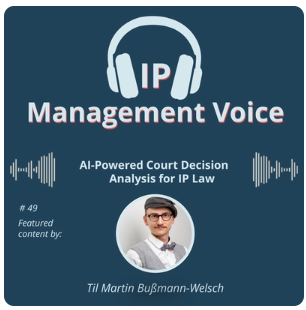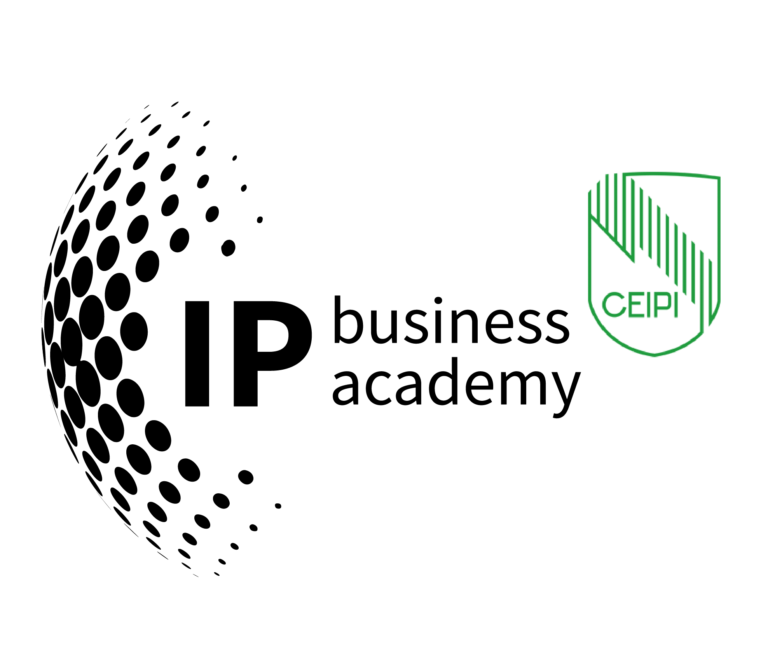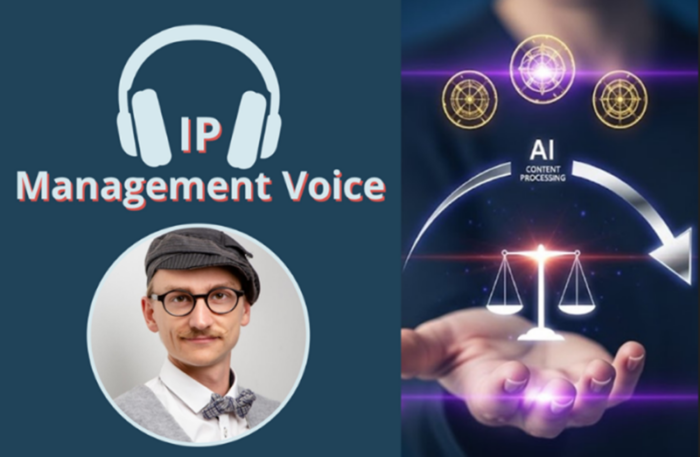Explainable AI in the Courtroom: Anita’s Breakthrough for IP Legal Practice
In episode #49 of IP Management Voice, we follow the journey of Til Martin Bußmann-Welsch, co-founder of the legal tech company Anita, whose AI platform is changing how court decisions are analyzed—starting with judge behavior and evolving into a transformative tool for IP law. The project began with academic curiosity: Bußmann-Welsch’s PhD research explored how external factors influence judicial decisions, from systemic biases to behavioral patterns. What started as a niche academic effort eventually became a cornerstone in the development of structured legal data analysis.
His early work laid the foundation for a highly practical question: how can lawyers quickly understand how certain judges think and rule? And more importantly—can that insight be made reliable, scalable, and useful through technology? The answer became Anita.
👉 Find here the digital IP lexicon 🔗dIPlex page on AI-powered Legal Research
A New Kind of Legal Intelligence Platform
Anita is a legal analytics platform that does far more than summarize past rulings. It enables lawyers to ask highly practical, data-driven questions: How often has a judge decided a certain way? What arguments are commonly successful in comparable cases? Which decisions carry strategic relevance for a particular legal scenario? Anita provides structured answers that can be used to support briefings, litigation strategies, or client advice—and it does so with a level of transparency that sets it apart in the emerging AI legal tech market.
You don’t just interact with a database; you ask natural-language questions and receive cited, verifiable responses that are integrated into legal workflows. This functionality reflects not only a technological leap but also a deep understanding of legal professionals’ real needs—especially in intellectual property law, where precision, reliability, and speed are essential.
Why IP Law Was the Right Fit
Initially, the company operated under the name “iur.crowd,” highlighting its early reliance on data contributed by legal practitioners themselves, given the scarcity of public court decisions in jurisdictions like Germany (with less than 1% of decisions published). But by late 2022, the landscape shifted with the rise of generative AI. The team saw that the real opportunity lay in focusing on one legal domain that was particularly open to new technologies: intellectual property.
Why IP law? As Bußmann-Welsch explains, IP experts—especially patent attorneys—are naturally immersed in technological change. Their field constantly interfaces with innovation, digital tools, and new regulatory environments. Compared to more conservative fields like M&A or family law, IP professionals are often better prepared to adopt new tech solutions. The pivot to IP law made strategic sense and aligned well with Anita’s core competencies: automation, transparency, and trust.
Explainability: The Antidote to Hallucinations
One of the standout features of Anita—and a central theme of this episode—is its approach to AI explainability. Unlike many generative AI tools that produce plausible-sounding but unverifiable outputs, Anita is built on explainable and transparent systems. This design philosophy directly addresses the problem of “hallucinations”—AI-generated content that is fabricated, misleading, or completely false.
The legal profession cannot afford hallucinations. In law, every quote must be real. Every case reference must be verifiable. Yet many generative models, including those used in legal tech applications, fail on this front. Studies have shown that some tools hallucinate in up to 30% of cases, and only a small fraction of users—just 7%—actually verify the references AI provides. This is a dangerous mismatch in a high-stakes industry.
Anita counters this by making every output traceable. When the platform generates a reference, users can click to immediately see the original source document. There’s no guessing, no ambiguous citations, and no black box. This explainability is not a buzzword—it’s the backbone of Anita’s trustworthiness.
The Importance of Source-Verified AI
Bußmann-Welsch’s team recognized early on that any AI tool used in the legal field had to deliver source-verifiable information. To demonstrate how other AI tools can fail this test, he recounts a story about asking ChatGPT for a quote from a well-known IP book. ChatGPT confidently provided a fabricated quote, attributed it to the wrong author, and couldn’t locate a source page—because the quote didn’t exist. This is the essence of hallucination: a made-up answer wrapped in the tone of authority.
Anita avoids this entirely. The platform doesn’t just respond; it explains. Lawyers can follow the path the AI took to reach its conclusions. That traceability builds the kind of credibility lawyers need to trust a system—and to use it in real client work.
Automating the Research That Slows Lawyers Down
A major benefit of Anita is its ability to automate the research activities that typically consume legal teams’ time and attention. Instead of spending hours searching through court databases, lawyers can ask Anita targeted questions and receive structured, cited answers. This streamlines litigation prep, improves client consultations, and opens the door to new kinds of analysis, such as comparing the decision patterns of multiple courts over time.
In IP law, this efficiency translates directly into business value. Lawyers can quickly identify trends in patent case outcomes, explore how courts treat specific technical claims, and develop sharper arguments—all based on data. But critically, the time saved doesn’t reduce the lawyer’s role. Instead, it frees legal professionals to focus on what matters most: strategy, creativity, and client advocacy.
Data Scarcity and the Role of Collaboration
In Germany and many other European countries, a core obstacle to building AI tools for legal analysis is the lack of public judicial data. With so few court decisions published, Anita had to find alternative sources. One of its early innovations was to build a legal community that shares anonymized court documents to enrich the platform’s knowledge base.
This crowdsourcing model—originating in the iur.crowd concept—remains a vital part of Anita’s ecosystem. Participating law firms benefit from more targeted insights, while contributing to a growing database that strengthens the tool for everyone. This collaborative approach reflects the values of IP law itself, which often balances openness with proprietary protection.
Branding with Meaning: The Name Anita
The switch from iur.crowd to Anita was more than a marketing move. It was a symbolic gesture toward credibility, clarity, and legacy. Anita Augspurg, the platform’s namesake, was the first woman to earn a PhD in law in Germany (albeit from a Swiss university, due to restrictions at the time). Naming the platform after her reflects a commitment to empowering legal professionals with smart tools, regardless of background or firm size.
It also makes the platform easier to remember, pronounce, and trademark—practical branding concerns in a competitive legal tech landscape.
What This Means for Legal Transformation
Anita’s development is a signpost for broader digital transformation in law. It shows that legal tech doesn’t have to rely on vague predictions or futuristic hype. With the right design, it can offer immediate, meaningful improvements—especially in data-heavy, analysis-driven fields like IP law.
The platform’s combination of automation and transparency points toward a new era in legal work. One where lawyers are not replaced by machines, but where their roles are elevated through trusted, verifiable technology. This shift has already begun, and IP professionals are leading the way.
Expanding the Vision: Beyond IP Law?
While Anita is focused on IP for now, the implications of its explainable AI architecture extend well beyond this niche. Any domain where facts must be precise, sources must be verifiable, and trust must be earned—from health care to finance—could benefit from a similar approach.
The key insight is this: as AI becomes more integrated into our professional lives, its value will depend not just on what it can generate, but on how transparently it can show its work. Anita exemplifies what happens when accuracy is non-negotiable—and when AI is designed to serve professionals, not just impress them.
Conclusion: Precision AI for the Legal World
 Episode #49 of IP Management Voice gives listeners a clear message: AI in legal practice is no longer theoretical. With platforms like Anita, it’s already here—and it’s working. By combining domain-specific focus, explainable outputs, and verifiable citations, Anita provides exactly what lawyers need to feel confident in using AI to augment their research and decision-making.
Episode #49 of IP Management Voice gives listeners a clear message: AI in legal practice is no longer theoretical. With platforms like Anita, it’s already here—and it’s working. By combining domain-specific focus, explainable outputs, and verifiable citations, Anita provides exactly what lawyers need to feel confident in using AI to augment their research and decision-making.
Especially in intellectual property law—where outcomes depend on precision, logic, and legal precedent—this kind of transparent, trustworthy AI is a game changer. It doesn’t just save time. It changes how legal insight is created, shared, and applied.



